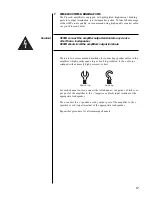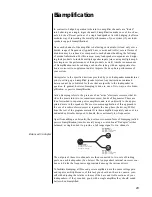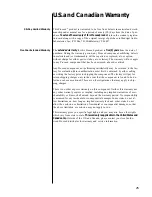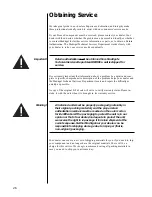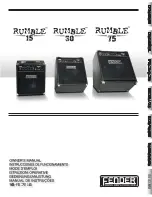
19
Balanced Bridging Kit
2 1
3
1 2
3
1 2
3
Female XLR Input
Pin 1: signal ground
Pin 2: (non-inverting)
Pin 3: signal – (inverting)
Male XLR Output (normal)
Pin 1: signal ground
Pin 2: (non-inverting)
Pin 3: signal – (inverting)
Male XLR Output (inverted)
Pin 1: not used (floated)
Pin 2: signal – (inverting)
Pin 3: (non-inverting)
Balanced Bridging
Input Adapter
(pin configuration)
Bridging Output Adapter
(not drawn to scale)
(shield not connected)
The “normal” leg of the Madrigal Balanced Bridging Input Adapter will be marked
with a red stripe to indicate positive polarity, and the inverted leg will be marked
with a black stripe to indicate inverted polarity (corresponding to the red and
black terminals of your loudspeaker).
The Balanced Bridging Output Adapter is simply a heavy-gauge copper bar (sil-
ver- and gold-plated) used to strap two of the output ground terminals together.
This establishes a common reference for the amplifier and completes the circuit
that includes the loudspeakers.
Important!
Do not attempt to operate your amplifier in a bridged mode
without first strapping the black output terminals together.
Failure to establish a common ground reference between the
two channels can damage your amplifier by forcing
significant currents to flow where they do not belong!
To bridge your amplifier using a balanced input signal, follow these steps:
1
DISCONNECT YOUR AMPLIFIER FROM EVERYTHING
Start with your amplifier totally disconnected from inputs, outputs, and AC
power. It is always best to power down an amplifier before changing con-
nections; here you are also changing its basic configuration, making this
step essential.
2
CONNECT THE BALANCED BRIDGING INPUT ADAPTER TO THE INPUTS
Connect the two male XLRs to two adjacent inputs on your amplifier, not-
ing which XLR is marked red and which is black. The channel with the red,
normal input will later be connected to the red, positive terminal of your
loudspeaker. Don’t forget to choose the balanced input on each channel us-
ing the switch located between the XLR and the RCA connectors.













